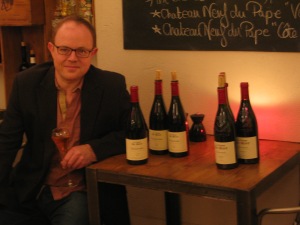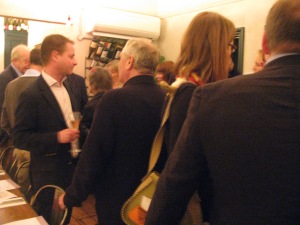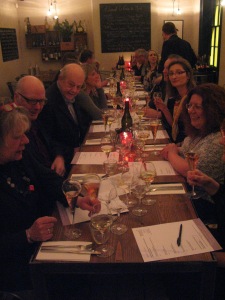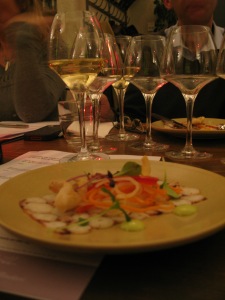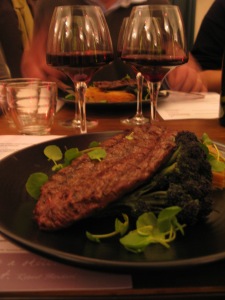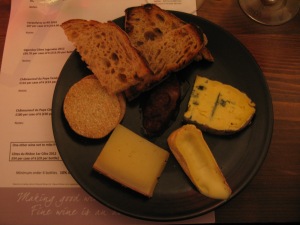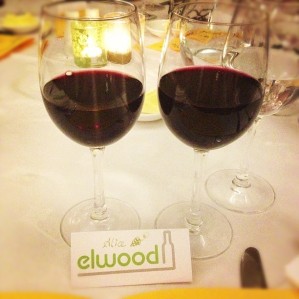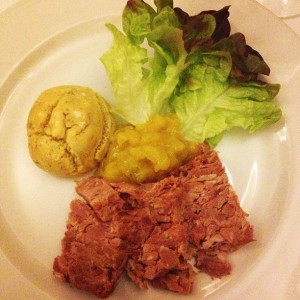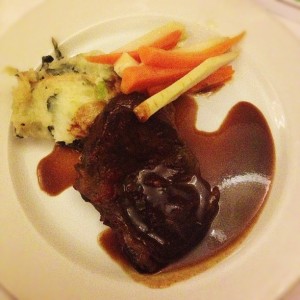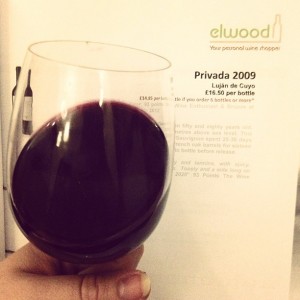Harvest time at Stopham Vineyard – 2014 vintage report
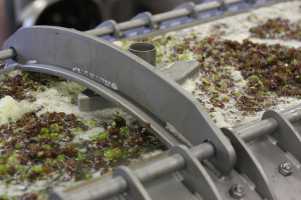 |
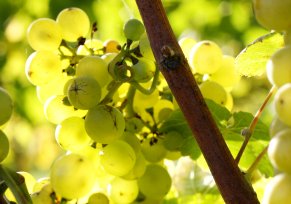 |
It seems a long time since the end of harvest, but here’s a summary from Simon Woodhead, proprietor and head winemaker, about what to expect from the 2014 vintage at Stopham Vineyard.
“The vines got off to an early start this year with a warm spring. A temperate flowering period at the end of June ensured good pollination, giving us a largest potential yield since planting.
The summer continued to be warm during ripening, culminating in perfect acidity (9g/L) and sugars (11.5%) for harvest at the beginning of October.
Despite the autumn rain coming in at harvest time, we managed to bring in 70 tonnes of grapes, which filled our tanks, including the 5 new ones that we got in this year.
Fermentations were temperature controlled to preserve the delicate fruit aromas, lasting 6-8 weeks. A combination of standard and wild yeast strains were used to increase the complexity in the wines.
Bottling will take place next spring, once the wines have been blended, fined, stabilised and filtered”.
In the meantime, elwood can offer you the excellent 2013 vintage from Stopham Vineyard.
Producer dinner : La Ferme du Mont, 12 March 2012
On the 12th March we descended upon Plateau in Brighton for an evening of food and wine featuring a range of wines from the renowned Southern Rhone estate, La Ferme du Mont.
Stephane Vedeau is the man behind this estate and I first met him nearly 9 years ago in a small cellar he was renting in Montpeyroux and looking back on this now I can fully appreciate my good fortune then to be able to taste and discuss his philosphy about the wines he strives to make. Since then, much has been written by the hugely influential wine critic, Robert Parker Jr, who has published rave reviews for Stephane’s wines since he first reviewed his Châteauneuf du Pape Cote Capelan 2007. The rest they say is history and the world changed over night for Stephane and the resulting demand for his wines, especially in the US.
Here’s a summary of the wines we tasted and the superb meal that Plateau produced to accompany them. If you ever head down to Brighton , then do check out Plateau as it is well worth a visit.
We started with octopus carpaccio, crispy squid, pickled vegetables, rocket and wasabi. This was served with the Côtes du Rhone Blanc, La Truffière 2013. The combination of flavours and textures of the starter worked really well with the aromatic and peachy Cotes du Rhone. The wasibi was just a mere dot on the plate and didn’t overpower the other flavours at all. A great start to the meal.
This was followed by the most juicy and perfectly rare Sussex onglet steak served with pommes boulangère that was a great match with the Vacqueyras le Rif 2010 and Gigondas Cotes Jugunda 2012. The Vacqueyras is packed with plump autumn fruits, with notes of lead pencil, tobacco and spice; the Gigondas by contrast had more red fruit emphasis and due to the high altitude of the vineyard there is exceptional elegance and finesses – the refreshing acidity gives the wine amazing poise and the tannins are very finely textured.
To round the evening off we paired Stephane’s superb “entry-level” Châteauneuf du Pape Vendange 2010 with the exceptional Châteauneuf du Pape Cote Capelan 2009 with a selection of fine cheeses. The Vendange is immediately accessible with a mesmerising display of ripe dark cherries, liquorice, red peppers, spice and wild herbs and a complexity that is remarkable at this price point. Although drinking beautifully now, this will continue to evolve for another 10 years. The Cote Capelan took us up to another level entirely. The difference here is a greater depth of fruit and even more complexity. The tannins are offering a lovely texture to this powerful wine and yet there is a freshness that leads to an almost burgundian-like silky finish. This wine has a long future.
Click here if you would like further details or to buy the wines listed here. Please note that the Cote Capelan 2009 has since sold out, but the 2012 is now being offered En Primeur.
Here are a few images from that evening and if this has tempted you to join us at a future event, then please do get in touch.
Burgundy : never have so many buyers sought so few wines
Some time ago a barrister once informed me that only clerks can afford Burgundy, so he drinks claret.
I’ve always been rather fond of the impression this statement has given me over the years as to how the lifestyles of barristers and their clerks differ. Whether there is any truth in this generalisation of the legal profession, it did reflect the perception at the time that Burgundy was priced out of most people’s pockets. Our learned friend would be well advised to reconsider his position, because in reality, Burgundy has not responded to market forces in the way claret has over the past 10 to 15 years and by comparison one could argue that fine Burgundy offers rather better value for money than top flight Bordeaux. However, getting hold of the wines is increasingly more difficult.
Burgundy harvests have been smaller than average since 2007 and even with the notable exception of the plentiful 2009 vintage, yields were low again in 2010. To make matters worse, there has been a terrible trio of back-to-back-vintages in 2011-2013. Although the quality of these last three vintages has resulted in some excellent wines made in challenging growing conditions, many producers have made up to 60% less wine. Every dedicated winemaker has a right to a decent living and with less wine to sell in the coming years, they will probably have little choice but to increase their prices. There’s more to this than simply yields, however if demand for Burgundy remains strong, then I suspect we have to accept that prices will increase.
So before our learned friends gloats “I told you so!”, we could all be well advised to snap up some well priced Burgundy while we can. Personally speaking, I think the more adventurous consumers among us will continue to be introduced by their wine merchants to well priced wines from Burgundy for a little while yet, so no need to panic!
Click here if you want to see our En Primeur 2012 offer or give Karl Elwood a call on 01273 242535 or karl@elwoodwines.co.uk if you would like any specific advice on what to buy right now.
elwood tasting event : Hidden treasures from Southern Italy
As part of the Brighton Food Festival this year, elwood hosted a wine tasting on Monday 9th September in support of Brighton & Hove Hospitals. The theme for this tasting was to look at wines from southern Italy – a source of many great wines that can fall below the radar of wine buyers, largely because they tend to be from lesser known regions. Italy is perhaps one of the most complicated wine producing countries to get to know, but there are so many hidden treasures here that it was a pleasure to introduce some of the wines we sell to a new audience. The focus was on Puglia and Sicily and the six wines we tasted were certainly worthy of the attention.
The tasting took place in the atmospheric Cellar Rooms under The Old Ship Hotel and proved to be just the tonic for an autumnal Brighton that evening. Here is a run down of the wines we tasted, but you can click here for some fabulous photos of the event, which were taken by Julia Claxton Photography – they sum up the evening rather well!
Our guests were greeted with a glass of the Carta d’Oro Catarrato 2012 from Cantine Rallo in Sicily. This indigenous white varietal from Sicily is a great alternative to a Sauvignon Blanc, not as pungent as a Kiwi version, but more along the lines of a Sancerre for example. This was followed by the rather obscure white varietal, Fiano, from Masseria Altemura in Puglia. This wine comes from vineyards in the Salento Penninsular, where the rather unique influence of two coastal oceans moderates the Mediterranean summer heat, a climate that is not generally ideal for dry white wines. The grapes were harvested when fully ripe and there are notes of ripe peaches and apricots and even a hint of a salty-tang – could this be the oceans influence? The producer behind this wine has great ambitions for the Fiano grape and having rescued it from obscurity, it is hard not to see its potential. According to ancient records, Charles I of Anjou was rather fond of this varietal – back in the 13th century – so time for a revival perhaps?!
We then moved on to the reds. Kicking off with two signature red varietals from Sicily, Nero d’Avola, we saw not only a modern example of the drink-ability of this grape, but also the future of its potential. The first example was the Il Principe 2012 from the Cantine Rallo stable again – vibrant red and dark berry fruits and very laid back charm. The second Nero d’Avola was from one of the most dynamic producers in Italy – Vito Catania who produces wine under the label Gulfi, which he established 10 years ago. Vito Catania has rapidly become one of Italy’s most celebrated winemakers and last year Gulfi was voted Winery of the Year by Gambero Rosso, the guide to the best Italian wines. If you’re a fan of a good Châteaneuf du Pape or Barossa Valley Shiraz, then the wines from this producer are certainly worth the detour. And so too were the last two reds from the renowned producer in Puglia, Apollonio, that provided the finale to our tasting. Our attention now switched to two local varieties for fine reds from Puglia, Primitivo and Negroamaro. Both wines were produced from vineyards located in the Salento Penninsular and as already stated, the unique climate and terroir here is producing world-class red wines. The Valle Cupa 2007, a 50/50 blend of Primitivo and Negroamaro was very much in the vein of a richly endowed Chateauneuf du Pape with its spice and hedonistic fruit profile. Whereas the Primitivo Terragnolo 2007 has the sweet aromatic spice and silkiness of a Rioja Reserva, with the peppery-kick of a Syrah from the northern-Rhone.
If this has whetted your appetite and you would like to read more about the wines mentioned here, then follow this link.
So what were the most popular – in other words what did people buy? There were three clear favourites (and the prices):
Fiano Salento 2012, Masseria Altemura @ £14.75 per bottle
Salento Rosso 2007 Valle Cupe, Apollonio @£16.50 per bottle
Nero d’Avola Nerojbleo 2009, Gulfi @£17.50 per bottle
For details on the rest of the wines we tasted, click here.
The Cellar Room under the Old Ship Hotel proved the perfect venue again and we look forward to our next outing here on the 17th October – Burgundy tasting and dinner, featuring the wines from Domaine Chanson.
If you’re interested in attending any of our further tasting events for 2013, then BOOK HERE.
Chablis – a lighter shade of gold. Karl Elwood attends a tasting and lunch with Bernard Billaud
I was fortunate enough to be invited to attend a tasting and lunch in London earlier this week with Bernard Billaud, one of the leading figureheads among Chablis producers. We were joined by other wine merchants and a splattering of the wine press.
In my opinion, Chablis is the purest expression of Chardonnay and unquestionably, one of the finest expressions of terroir anywhere in the World. Bernard Billaud recalled as a child when his father Jean Billaud and his grandfather Jules Simon asked him to taste the grapes, pointing out that fruit from the vine produced from each plot, from one vine to another, does not have entirely the same taste, each one having a distinctive and different subtlety. This lesson in terroir cearly stuck with him and why it is important to Bernard that each wine he produces accurately reflects the geography and climate of the site on which the grapes are produced. Afterall, this is what makes wine producers like Bernard get out of bed in the morning!
All of the vines within this domaine are planted on the signature soil of the region, Kimmeridgian, which typifies the geology of this burgundian outpost. This unique limestone and fossilised-oyster soil composition is what makes the very fabric of the white wines from Chablis so exciting. The characteristic citrus and iodione descriptions for these wines is because of the soil. This tasting was agreat lesson in terroir.
I think it is also worth pointing out that within the burgundian hierarchy, Chablis produces exceptional value for money. I was reminded of this fact when you consider prices being charged for wines of this quality further south in the Cote d’Or. There are very few domaines that can offer exceptional 1er Cru for less than £250 a case In Bond, or Grand Cru for less than £500 IB – fat chance finding anything of similar value in Puligny or Meursault for example. Yet Chablis is often overlooked by wine consumers, instead tempted by her more vivacious or should I say, curvaceous, cousins in the south.
Here’s the line up of wines we tasted and please do contact Karl Elwood if you would be interested in purchasing any of these wines.
Tasting from the 2011 vintage – the 1er and Grand Crus were all bottled within the last month, so the first chance to taste post bottling:
Petit Chablis – very impressive weight of fruit for this AOC. Very fresh, bright and drinking even now.
Chablis – Honeyed on nose and wonderful concentration for a village wine. Racy and steely with great precision.
Chablis Tete d’Or – one of the few wines that the domain ages in barrel (2o% of the cuvée). Creamy with excellent backbone of acidity
1er Cru Vaillons – plenty of character and a classic example of Chablis 1er Cru
1er Cu Montée de Tonnerre – Very stony nose, wonderful concentration and enough steely acidity to cut glass with! Needs time but fab.
Grand Cru Vaudésir – Very honeyed nose with a touch of vanilla. Rich and full on the palate and wonderful poise. Very persistent finish.
Grand Cru Les Preuses – super-concentrated and very impressive.
Grand Cru Les Clos – Packed with minerals, great depth of ripe stone fruit character. Much more refined and elegant than Les Preuses. A knock-out!
Then a selection of various vintages
1er Cru Les Vaillons 2010 – Rich, yet a fine backbone of acidity. Beautiful poise and ideally suited for drinking now and over the next 5 years.
1er Cru Mont de Milieu 2010– More honeyed character on nose and palate. Wonderful length.
Grand Cru Vaudésir 2010 – Great prescion, depth, length and complexity. This is stunning and would reward keeping 2 or 3 years.
1er Cru Montée de Tonnerre 2009 – the ripest vintage of the tasting, which shows as hints of tropical fruit on the nose and rich and ripe fruit on the palate. Personally I prefer the steelier nature of the 2010s and 2011s, but this is still very good indeed.
With lunch – I know, it’s a hard life!
1er Cru Mont de Milieu 2009 – None of the tropical fruit notes that defined the Montée de Tonnerre. Finer and much more elegant. Drink now plus 4 years.
1er Cru Mont de Milieu 2007 – love this wine! Touch of lychees on the nose, ripe white peaches on the palate and great length. This has definitely put on weight since it has been bottled and shows how underrated this vintage is.
1er Cr Montée de Tonnerre 2006 from magnum – If ever there was an argument to buy white wine in magnum, then this is it. 2006 was another ripe vintage for Chablis and yet the slower evolution of this wine as a result of being in a magnum as opposed to a regular bottle, has undoubtedly suited this vintage. Creamy, honeyed, spicy, citrus notes. Stunning!
Grand Cru Vaudésir 2008 – Not fair after the 2006, so was rather muted by comparison. Needs another 3 or 4 year to reach its prime, but no doubting the potential for this elegant classic.
Grand Cru Vaudésir 2006 – great to be able to compare these two vintages. Like chalk and cheese, with this beiung the latter. Very rich and still has enough vibrant citrus fruit to carry it off.
Grand Cru Les Clos 2000 from magnum – and what a way to end. This wine has still retained the green tinge of youth in appearance – any Cote d’Or white would be a rich golden colour by now. This is incredibly fresh considering its age. It’s rich, vibrant personality suggests to me that this has some time ahead of it yet. Should point out that this wine came from Bernard Billaud’s personal cellar, so may well demonstrate the importance of cellarage as it does for the longevity of the great wines from Chablis when aged in magnum.
It was a great honour to be able to taste and enjoy these wines and do get in touch if this has tempted you to want to try some for yourself.
Karl Elwood

With the cold embrace of winter firmly still upon us, some antipodean sunshine is surely welcome about now. We’re delighted to be hosting a wine tasting and dinner at Drakes Hotel in Brighton to showcase the superb wines from South Australian winery Chapel Hill. Furthermore, elwood are fortunate to have Marc Allgrove, CEO of Chapel Hill, joining us whilst he is here in the UK on business. Marc will be able to talk us through the wines and bring us a little closer to actually being there amongst the vines!
Our three course tasting menu has yet to be finalised, but after a glass of Champagne Deutz Classic on arrival, we will be tasting the following six wines over the course of the meal:
- Unoaked Chardonnay 2010
- Verdelho 2009
- Parson Nose Shiraz 2011
- McLaren Vale Cabernet Sauvignon 2010
- McLaren Vale Shiraz 2010
- McLaren Vale Grenache 2010
Places are very limited and cost £65 per person inclusive of food and wine. Book online now or please contact karl@elwoodwines.co.uk or telephone 01273 242535 if you would like more information.
Further details will be announced soon.
About Chapel Hill
McLaren Vale was the birthplace of the South Australian wine industry and is home not only to some of the world’s oldest vines, but many characters recognised as the fathers of Australian wine. Nestled between rolling hills and a picturesque coastline, McLaren Vale’s Mediterranean climate has created ideal conditions for wine production and ensured that the region is recognised as a leader in environmentally sustainable viticulture.
Chapel Hill winery takes its name from the historic ironstone chapel built on the property in 1865. It has served as a local church, parish school, and now the cellar door. In line with many leading wine producers in Australia today, Chapel Hill is extremely conscious of their environmental responsibility. As well as closely monitoring their water and energy uses, they follow bio-dynamic principals in their vineyard work. The exceptional quality of fruit this delivers at harvest time rewards them with beautifully pure wines that have excellent texture, complexity and ageing potential.
In short, Chapel Hill produces exceptionally well made wines that are accessible in youth, very reasonably priced and a great example of the shift in Australian wine making from the massive, fruit-driven styles of old to the more complex and stylish wines that we are enjoying today.
Hope you can join us!
elwood winter tasting 15 November 2012: the finishing touches to a festival of the senses
On Thursday 15th November, elwood will once again be taking over the reception and conference room at Lighthouse Arts in Kensington Street – just off North Road in Brighton – for our Winter Tasting.
We’re delighted to have use of this glorious space in which to showcase the best of our autumn and winter wines, and have some exciting plans to make this a very memorable event.
Haven’t booked yet? Perhaps this can persuade you.
Not only will you be able to sample and buy 40 wines for your Christmas drinking or as gifts, you will also have a chance to try some fabulous Sussex cheeses selected by La Cave a Fromage and exceptional hand-made chocolates from Chocoholly.
We will publish the wine selections shortly, but here are the cheeses that you can look forward to trying:
Golden Cross Goat’s Cheese, Greenacres Farm, Whitesmith
Golden Cross Flower Marie, Greenacres Farm, Whitesmith
Lord of the Hundreds, The Traditional Cheese Dairy, Stonegate
Sussex Camembert, Alsop and Walker, Five Ashes, Mayfield
Burwash Rose, The Traditional Cheese Dairy, Stonegate
Sussex Blue, Alsop and Walker, Five Ashes, Mayfield
Click here for more information on these amazing cheeses.
For all you fine chocolate lovers out there, Holly Caulfield from Chocoholly will be preparing a myriad of exceptional organic hand-made chocolates to tempt you with on the 15th. Look forward to sampling fresh truffles, salt caramels, champagne truffles, vanilla and nutmeg truffles, Madagascan truffles, chilli & amaretto truffles – all made with fresh cream and no artificial flavours or syrups.
Have you ever tried raw chocolate made without sugar? As well as 98% chocolate buttons, 85% chocolate bars, special Christmas bars with candied orange & almonds with dark organic chocolate. Holly will also bring along some gift packs for Christmas and Chocoholly workshop vouchers for children and adults to enjoy a deluxe chocolate making experience at their Hove shop
Both David Deaves, manager of La Cave a Fromage in Hove and Holly Caulfield, owner of Chocoholly, will be on hand thoughout the tasting to talk you through their local produce.
There will also be an opportunity to taste and purchase some bottles of the new Beaujolais vintage – this date coincides with Beaujolais Nouveau day, so be the first to try the 2012 from Georges Dubeouf.
All the above for only £30 per person and with discounts being offered for orders placed on the night, you may even earn the cost of your ticket back!
It’s not too late to book our winter tasting on the 15th November, so don’t miss out!
Karl and elwood’s team of experts will also be on hand throughout the evening to talk about the wines too and help you buy your ideal bottles ready for winter and the Christmas festivities ahead.
Hope we see you there!
For more information, call Karl on 01273 242535.
 Further to an earlier post regarding the growing demand for half bottles, we have just released an offer for these handy sized bottles, as well as some larger formats – from magnum to Imperial.
Further to an earlier post regarding the growing demand for half bottles, we have just released an offer for these handy sized bottles, as well as some larger formats – from magnum to Imperial.
Click here to download special offer for half bottles and larger
Half bottles make an ideal choice if you just want a couple of glasses of wine, or to try a little of two different wines. Larger bottles are a great treat for dinner parties if you have a crowd of thirsty friends round, but they also make excellent gifts.
Upcoming elwood tasting: How to spot a faulty wine
Make sure you put Thursday 18th October in your diaries, as The Essential Wine School and elwood have been working on a very special wine tasting that will take place at The Old Ship Hotel in Brighton.
Many years ago, Karl Elwood organised a wine tasting in London that focused on the common faults in wine and how to spot them. Now, you’re probably thinking that it’s unusual to invite customers to taste wines that – to put it bluntly – you wouldn’t want to drink, but the tasting proved such a hit that we decided to repeat it in Brighton.
It’s rare that consumers have the opportunity to experience wine faults in a controlled environment, so we’re very much looking forward to sharing some of our “bad” bottles with you!
Throughout the tasting, we’ll compare wines which have been ‘doctored’ to replicate a particular, naturally occurring fault alongside the same unaffected wine. So don’t fear – there will be something enjoyable to taste too.
Bookings are being taken now if you’d like to come along.
We’ll look at four common faults on the night, and the samples we’ll be trying will all contain elements that may naturally occur in wine to a greater or lesser degree – and that’s the crucial thing – a little of these elements can be beneficial and enhance the character of the wine, but too much will detract from it.
Fault 1: Exposure to heat
Have you ever wondered about the condition of dusty wine bottles displayed under bright lights in shops?
When you’re buying a decent bottle or case of wine that has the benefit of some bottle age, you want to be sure that it’s been stored correctly. Provenance is key to buying fine wine – but the same care should be applied when purchasing any decent bottle.
Exposure to sunlight and the resulting heat source will effectively “cook” the wine , ridding it of any freshness or balance and leaving behind an overriding impression of stewed fruit. As the liquid expands inside the bottle, you may notice some seepage through the cork and down the sides of the neck. This is much easier to spot with red wine, but another sign is the slight protrusion of the cork forced upwards by the pressure of the liquid within.
Another consequence of the cork being moved upwards in this way is that once the wine cools, this is likely to draw oxygen into the bottle – thus leading to the possibility of oxidation.
Fault 2: Oxidation
The second sample of wine we’ll taste will be exposed to excess oxygen. Whilst a little air can help a complex wine develop its flavour, unwanted oxygen can pass through the pores of an oak barrel or – it is thought – in tiny amounts through the cork stopper.
Some wine is deliberately exposed to high levels of oxygen in order to change its character – and in some circumstances this can work. Sherry just wouldn’t be Sherry without the effect of exposure to the air, would it?
Normally a wine that has been exposed to excess oxygen will darken in colour, lose its fresh, fruity character and start to smell musty and stale. Eventually it will turn to vinegar (literally “sour wine”) and then fall apart completely.
Fault 3: Corked
This indiscriminate threat to wine is less prevalent now, thanks to the greater number of wines that use screw cap closures. A “corked” wine has nothing to do with pieces of cork floating in the glass – it’s an unpleasant aroma and change to the taste caused by the presence of a particular chemical.
The culprit is 2,4,6-trichloranisole (usually, and thankfully, shortened to TCA) which arises from fungi found in corks but – as anyone who has detected that musty, drain smell and disappointing finish in a wine without a cork can attest – there are other sources.
The effects of TCA are often confused with other problems. Though rare today, poor hygiene during filtration can cause a similar stale, damp cardboard smell. Bottle sickness (or bottle stink) can arise from a number of causes too, but will disappear after a short time after opening.
TCA, however, will not only affect the smell but also cause an overall dullness – so sometimes even at low levels TCA just makes a wine very disappointing, without necessarily the distinctive unpleasant smell.
Fault 4: Brett
The last faulty wine to be shown will demonstrate the effect of a particular strain of yeast called Brettanomyces. This naturally-occurring yeast creates a number of by-products during fermentation, and the effect of two of them is noticeable in wine if present in any concentration.
The volatile phenol 4-ethylguaiacol gives spicy and smoky aromas, which can be very attractive in many a complex red wine; while the other volatile phenol 4-ethylphenol is generally less appealing, giving flavours described like an old pair of boots or animal. A classic tasting note of some Shiraz wines from Australia a few years ago might have been “sweaty saddle” and was attributed to the combination of grape variety and volcanic soil – but we now know it was Brettanomyces, usually referred to as “Brett”.
Whilst careful monitoring can alert to excessive Brett and good hygiene reduce problems, only sterile filtration and addition of chemicals can eradicate it completely from a winery’s output. Both of these are increasingly frowned upon by quality winemakers, and the growing trend towards organic and biodynamic wines.
Maintaining sufficient sulphur dioxide can also prevent excessive Brett, but as always the clever winemaker has to have a balanced approach.
—
If you’re interested in attending this elwood wine tasting in Brighton on 18th October 2012 then please call Karl Elwood on 01273 242535 or book online – and the next time you’re served a wine, either at home or in a restaurant, you can exercise your consumer rights with newfound confidence, and send the faulty wine back!
Elwood Tasting: Producer’s Dinner with Bodega Norton
Written by Alice Reeves
Last week, elwood launched a new event series in a new venue, holding their first Producer’s Dinner at Blanch House. Brighton’s original boutique hotel – just recently re-opened – this gorgeous Georgian terrace is a chic, stylish, friendly little place in Kemp Town; the perfect spot to showcase a vineyard with a pretty quirky story…
About Bodega Norton
It was an immense pleasure to meet with, chat to and hear from Bodega Norton’s representative Diego Surazsky, who captivated everyone with the tale of the winery’s unusual beginnings. Founded in 1895 by Edmund James Palmer Norton – an English engineer working on the railway connecting Mendoza to Santiago – it all began with a love story. During his time in Mendoza, Norton fell for and married an Argentinean girl, whose family presented him with some land as a gift. It was here that he decided to plant a selection of vines imported from France – and Bodega Norton was born.
The Wines & The Food
Blanch House put together a special menu for the evening, designed to bring out the very best in the wines Diego decided to share with us – and the matching was absolutely spot on.
Here’s my verdict…
Pre-starter: Falafels with Tzatziki – delicately spiced and delicious, these warm falafels were served with a cool cucumber and mint tzatziki topping (plus plenty of smiles and welcoming words from Blanch House’s lovely staff!)
Wine: Finca La Colonia Sauvignon Blanc 2011 – I could hardly believe this was a Sauvignon Blanc; it has such a refined, smooth finish with hardly any acidity. The perfect blend of citrus and floral, this is a winner at just £7.95 per bottle.
~
Starter: Ham Hock Terrine with Sweet Piccalilli and gluten-free Mustard Bread – as well as gaining bonus points for use of gluten-free bread, the terrine was divine. I’m a pickle fiend, so the home-made piccalilli was the perfect accompaniment. Great twist on a British classic.
Wine: Lo Tengo Torrontes 2010 – after buying the Lo Tengo Malbec following elwood’s summer tasting, I had high hopes for its white partner. I wasn’t disappointed. Aromatic, smooth, vibrant and very similar to a Viognier or Gewurztraminer, this is one of the most fabulous whites I’ve found in a while. What’s more, it’s under a tenner at £9.95!
~
Main course: Featherblade of Ditchling Beef with Colcannon – I’m always a fan of local meat, and Blanch House’s Sussex beef was cooked to perfection. Braised and roasted until it was unbelievably tender, you could have cut it with a spoon and it just melted in the mouth. Divine. Creamy colcannon and plenty of gravy complemented the meat marvellously.
Wines: Reserva Malbec 2009 & Reserva Cabernet Sauvignon (both £12.95) – time for two robust reds to accompany the beef. First we sampled the Malbec which was fruity, spicy and warming; but the Cabernet was my favourite of the two by a mile. Robust and ripe, this was a huge mouthful of cherries with a chocolaty twist. I went back for more!
~
Dessert: Cheese Board – selection of three cheeses served with oatcakes (more gluten-free points), chutney and grapes.
Wine: Privada 2009 – move aside for the star of the show; this blend of Malbec, Merlot and Cabernet Sauvignon was out of this world. After the red fruits of the previous wine, this tasted much darker with blackberry and blueberry flavours packing an almighty punch. The lingering finish was incredible. At £16.50 it’s a little pricier than the rest, but rightly so – you get what you pay for, as I’m sure Karl will tell you.
~

